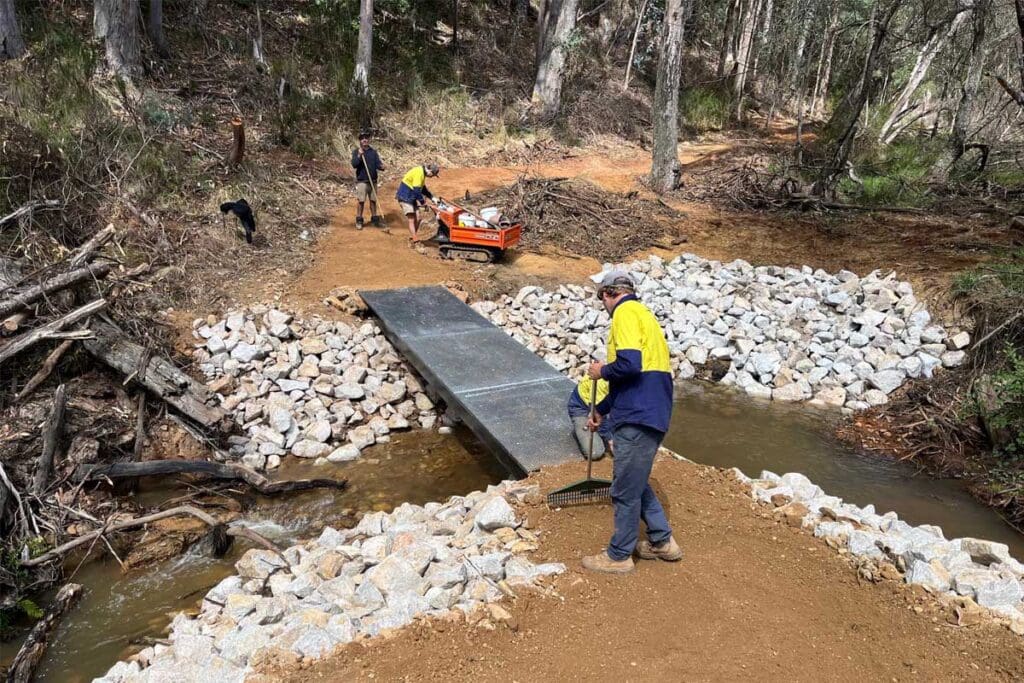Warburton Manager Calls For MTB Industry Organisation

Warburton, Victoria
Australia’s mountain bike industry has reached a level of maturity that now demands its own industry body, to effectively regulate the industry and collectively represent its interests, according to the project manager behind the recently approved Warburton MTB Destination in Victoria.
The unprecedented campaign to gain approval for Australia’s first gold-level mountain bike facility has highlighted the considerable need for an MTB-specific industry body, according to Yarra Ranges Council executive project manager Matt Harrington, as the seven-year, $5 million planning and design campaign for Warburton nears its end.
Matt says the industry would benefit greatly from a national body that can oversee training and accreditation for trial builders and other operators, and give the industry an image overhaul so the public perception of mountain biking more accurately reflects the reality of most trail users.
The latter in particular could have helped smooth the path towards approval for the Warburton facility, 60km east of Melbourne.
He said the common perception of mountain biking as an extreme sport – often perpetuated by the sport’s own promotions, with fearless riders negotiating rugged terrain or creating plumes of dust around corners – conjured concerns among the wide community about its impact on sensitive environments.
Bicycle Industries Australia general manager Peter Bourke said the would welcome a structure that offers greater support to the MTB sector, and includes manufacturers, importers and retailers.
“Obviously with the restructure of the sport and competition side with the transition from MTBA to AusCycling, it has changed the landscape significantly,” Peter said.
He added the International Mountain Bike Association had an Australian office that closed its doors almost 10 years ago and had a structure that would support the objectives Matt was proposing.
Income and Maintenance
Amid the rapid growth of mountain bike and MTB facilities in Australia in recent years, an industry body could also examine and develop essential guidelines on effective maintenance of the hundreds of kilometres of trails being professionally constructed.
It could also coordinate industry discussions about the possible introduction of user-pays measures to make MTB facilities more financially self-sufficient.
“We don’t have anyone representing the voice of mountain biking or trail construction as a whole and for me that would be a really good starting point to address challenges facing the industry,” Matt said.
“MTBA is now absorbed under AusCycling and they’re not really industry focused. They’re more in the racing and recreational rider space.
“There’s a growing need, particularly with issues of accreditation. Look at the amount of money in the trail building industry and the overlap with recreation, participation, sport and racing and how that could be brought together into one entity, or at least with collaborating entities.”
Quality Assurance
Matt said in the absence of an MTB industry body, and with everything Yarra Ranges Council has learnt through the Warburton MTB project, it gets contacted by a lot of local and State government agencies looking for advice on procurement for mountain bike trails or pump tracks.
“Local councils wanting to develop trails don’t have great internal knowledge on the subject and there’s no easy way for them to get reassurance about the quality of product they’re buying because there’s no accreditation of trail builders or even formal training for trail building staff,” he said.
“There’s nothing they can point to along the lines of other industries, where there’s accreditation or certifications, things you can tangibly look at and see a guarantee of quality.
“We should be taking a leaf out of the other industry bodies in Australia, such as the manufacturing industry.
“Look at the bodies working well for other industries and massage that a bit to suit our unique needs.”
Matt said that included moulding it to the scale of an MTB industry that is growing but still relatively small.
“We’re typically looking at companies with 20 to 40 people and turnovers that aren’t massive, so what does the funding model look like to support an industry body,” he continued.
“The organisation needs a holistic approach that includes the businesses linked to the trails once they’re operational. Then you get a broader range of participation, more membership and therefore more influence.
“In the States you have the Professional Trail Building Association. That’s a model that can work but for it to work well in Australia there has to be strong links to government agencies as well.
“A couple of our trail building companies have joined up with the Professional Trail Building Association in the States. However, that doesn’t really represent a local view or have influence on Australian governments.”
Matt said an industry body was also necessary for the “inevitable” arrival of a widespread user pays model in Australia, particularly for destination-scale facilities.
“The old days when you could build 10 or 15km of trail and a local clubs could maintain it is very different to when you’re looking at building one hundred plus kilometres of trails,” he said.
“Many destinations are being built without a maintenance plan or having a way for revenue to come in and support maintenance and operations.
“Many of these trail systems have been funded by local, State or federal governments looking to leverage the jobs and economic outcomes.
“But you don’t get return visitation unless your trails have been maintained really well. That’s one thing Derby has done fantastically, really keep on top of maintenance.
“It’s going to become an industry issue but there’s no industry-wide approach to address it.”
Join the conversation
Has the time arrived for an MTB industry body?

Simon Purssey
4:32 PM (0 minutes ago)
to me
I think there would be more private organisations involved if there was clarity protection and indemnity if there were an accident at a trial. gods forbid.
Governments/Councils would also be encouraged to support where there was no “chain of responsibility” on them.
How – QR code waiver signs, before during and after the trial.
In a nutshell, ‘lawyers are helping to destroy’ most fun times!